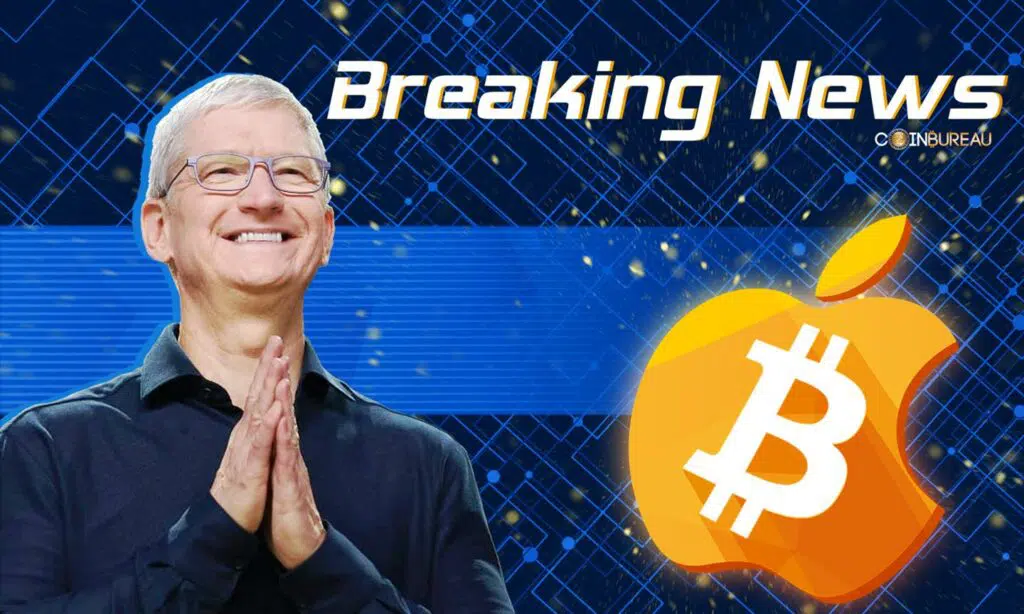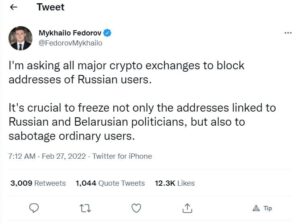Did you know that Vitalik Buterin created Ethereum after he realized Bitcoin could not effectively support smart contracts? Privacy coins like Monero and Zcash were created for the same reason: their founders saw that Bitcoin could not support the degree of privacy they wanted. It should come as no surprise then that both Monero and Zcash are actually privacy-focused forks of Bitcoin.
While we may not see any groundbreaking smart contracts or bulletproof privacy on Bitcoin any time soon, there are some projects that are trying to get us as close to that point as they can. Blockstack is one of these projects. However, it is not just another layer-2 scaling solution like the Lightning Network. Blockstack bring smart contracts and privacy to Bitcoin by anchoring its blockchain to Bitcoin’s.
A Brief History of Blockstack
Blockstack was founded in 2013 at Princeton University by Muneeb Ali and Ryan Shea. Muneeb holds a PhD in computer science from Princeton and Ryan holds a bachelor’s in mechanical engineering with a minor in computer science.

Blockstack founders Muneeb Ali (left) and Ryan Shea (right). Image via CoinDesk
Both were co-CEO’s of Blockstack until 2018, when Ryan left to start his own company that would focus around addressing what he believes are the greatest issues facing humanity today. This was not all that noticeable of a change from the outside given that Muneeb has been the de facto face of Blockstack since its inception.
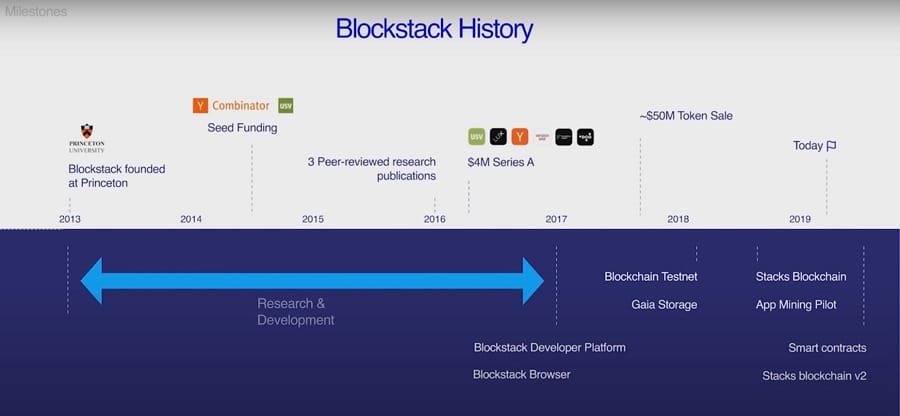
Image via YouTube
Similarly to Cardano, Blockstack’s early development was guided by academics from both Princeton and Stanford. The first four years of Blockstack focused almost entirely on research and development, with initial seed funding for the project coming at the tail end of that 4-year period.
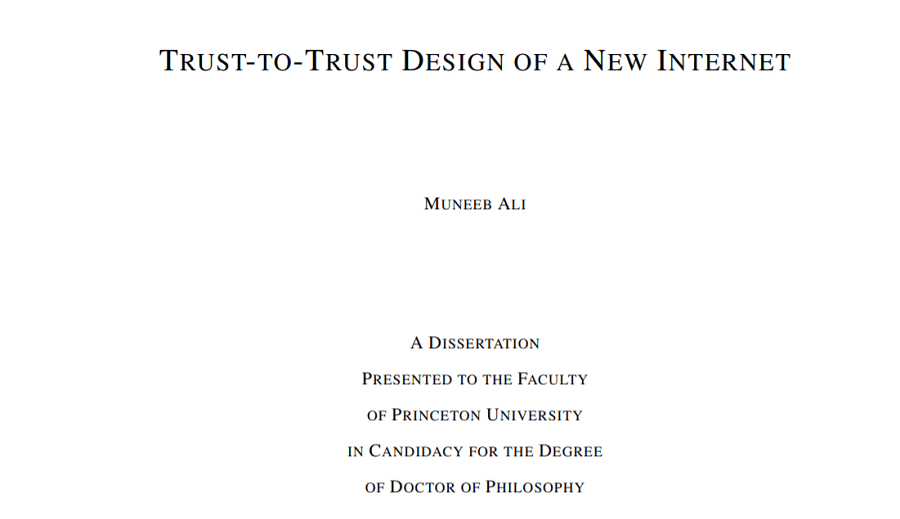
Blockstack founder Muneeb Ali’s PhD thesis.
This is mainly because Blockstack was actually the subject of Muneeb’s doctoral thesis, which sought to realize the internet’s original design as a peer-to-peer network absence of intermediaries. In addition, Blockstack would preserve the privacy of users by giving them complete control over their information and any data they generated when interacting with applications and platforms with this new web.

Edward Snowden at Blockstack’s 2018 event in Berlin.
Blockstack’s 2018 initial coin offering was one of the first to be sanctioned by the United States Securities and Exchange Commission. The project also garnered a fair amount of attention for its conferences which featured speakers including Andreas Antonopoulos and Edward Snowden.
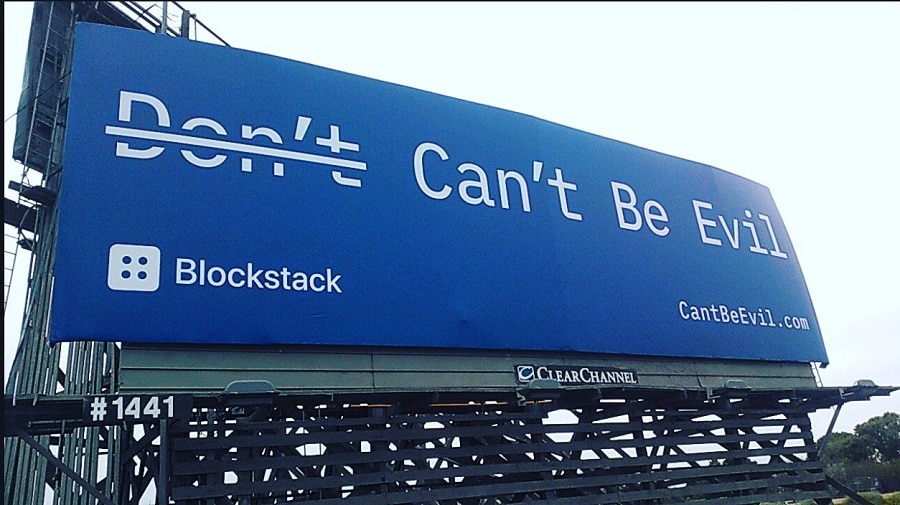
In June 2019, Blockstack went viral after buying a billboard across the street from Google’s California headquarters which read “Can’t Be Evil”, a reference to Google’s now abandoned code of conduct of “Don’t be Evil”. This is the semi-official slogan of Blockstack and refers to their view that tech giants should not have the power to ponder whether to be evil in the first place.
What is Blockstack?
Blockstack is a cryptocurrency project which seeks to build an open-source network on top of Bitcoin. At a topical level, Blockstack is intended to function as the application layer to the internet, one which is currently occupied by those aforementioned tech giants.

Blockstack as the application layer of the internet.
While Blockstack has its own blockchain, that blockchain is “anchored” to Bitcoin’s. In simple terms, everything that happens on the Blockstack blockchain can be verified on the Bitcoin blockchain, and Blockstack’s consensus (mining) mechanism is tied to Bitcoin. Blockstack makes it possible to build decentralized applications and smart contracts on Bitcoin by extension (via Blockstack).
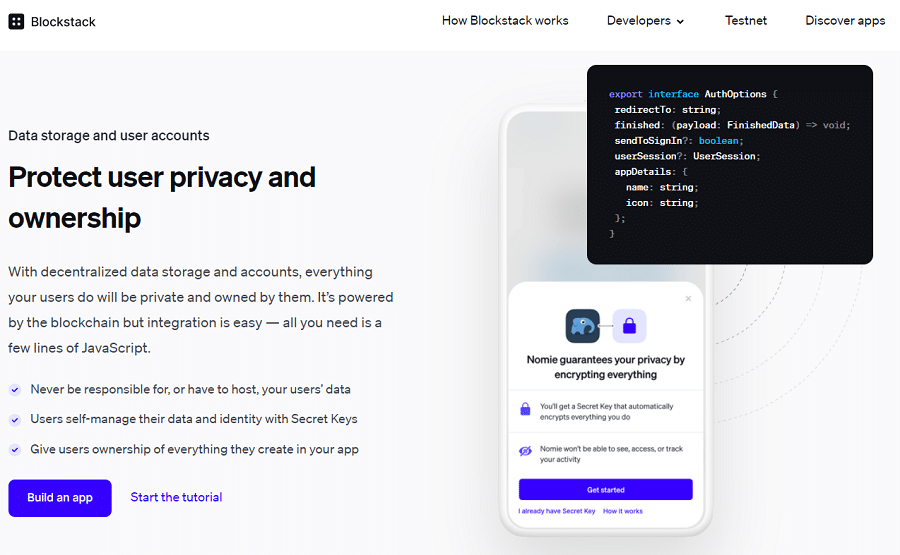
One of the unique value propositions of Blockstack.
Additionally, all users on the Blockstack network have ownership and control over their data when interacting with these dApps and smart contracts. This gives them an enhanced level of privacy compared to the current internet, wherein all data is owned and stored by tech giants such as Google, Facebook, and Microsoft.
How does Blockstack work?
There are quite a few components to the Blockstack ecosystem. For sake of simplicity, this article will focus on Blockstack’s consensus mechanism, the Blockstack blockchain, Blockstack’s user identity system, how Blockstack stores data, and Clarity, Blockstack’s programming language.

A technical overview of Blockstack’s architecture.
Blockstack Proof of Transfer Explained
Blockstack’ blockchain uses a novel consensus mechanism called Proof of Transfer (PoX for short). PoX involves two parties: miners and stackers. Miners on the Blockstack blockchain commit their Bitcoin for a chance of mining a block to earn STX tokens. Stackers “stack” (read: stake) their STX tokens to secure the network and earn the Bitcoin being committed by miners as reward.
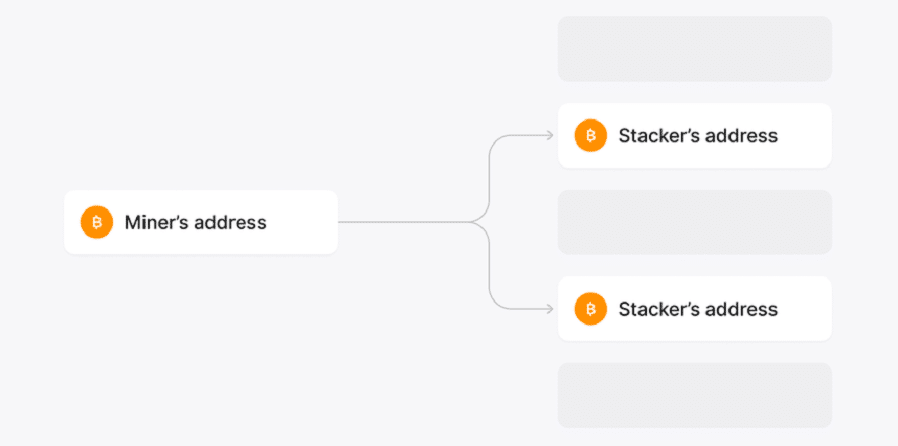
A simple visualization of mining on Blockstack.
While the exact rewards to be earned by stackers may change in the future, they must stack (read: stake) at least 94 000 STX tokens which are locked for a 10-day period. They will earn 9-10% of their stake in BTC per year assuming 50% of the liquid supply of STX is participating. Miners will earn 1000 STX per block for the first 4 years after the 2.0 main net launches.
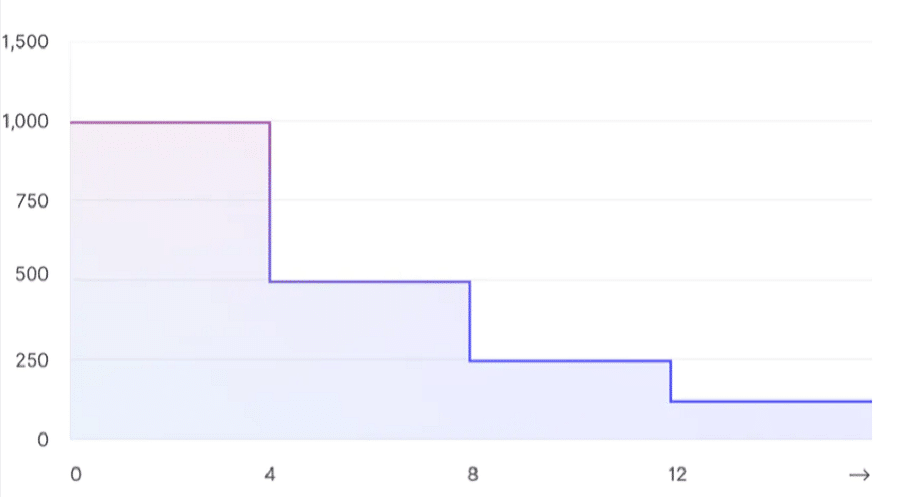
The halving schedule for Blockstack’s STX token.
This reward will be cut in half every 4 years in parallel with Bitcoin’s halving cycle for a 12-year period. STX mining rewards are paid for using inflation (more on this later). The exact amount of Bitcoin miners will have to commit to mine a block is also undefined, but their chances of being chosen depends on how much Bitcoin they commit.
Blockstack Blockchain
The Blockstack blockchain mirror’s Bitcoins in that a new Blockstack block is created every time a new Bitcoin block is created (roughly every 10 minutes).
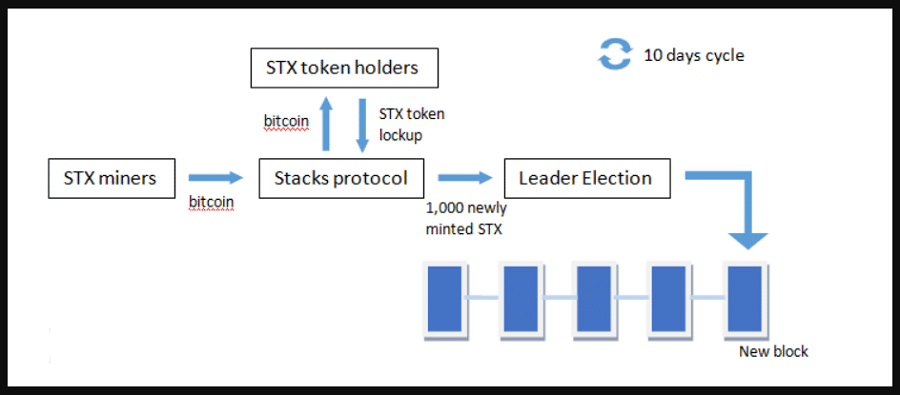
Image via Ethan Tan
The only data stored on the Blockstack blockchain is registered user identities and their transactional metadata. User identities include things such as decentralized applications and smart contracts.
What is Blockstack Auth?
Blockstack Auth is Blockstack’s user identification system. It makes it possible to use the same login credentials on every app built on Blockstack.
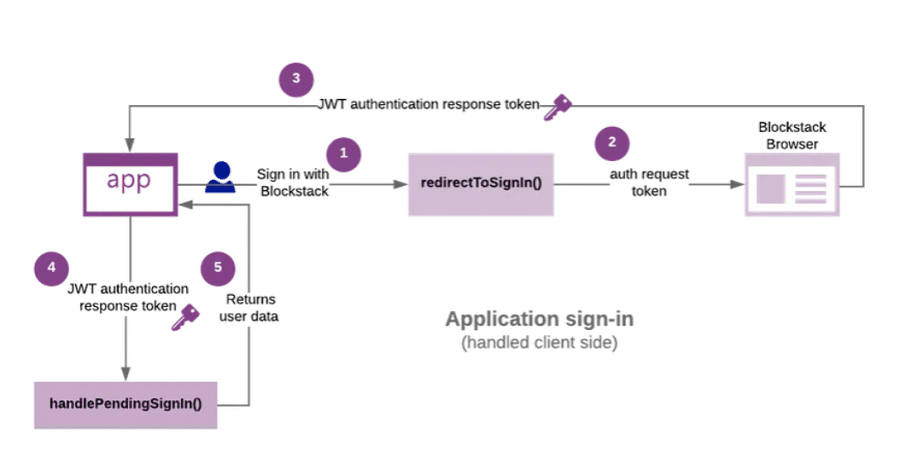
A technical overview of Blockstack Auth.
Blockstack Auth is also used to access and managed user data, which is stored off-chain in a storage system called Gaia.
Blockstack Gaia Storage System
The Gaia Storage System is where Blockstack stores all user data generated in its ecosystem with the exception of user identity and transactional metadata. Gaia consists of a handful of cloud service providers including AWS 3 and Azure. Data is entirely in the control of users, which use Blockstack Auth to manage their data permissions with the various applications they interact with.
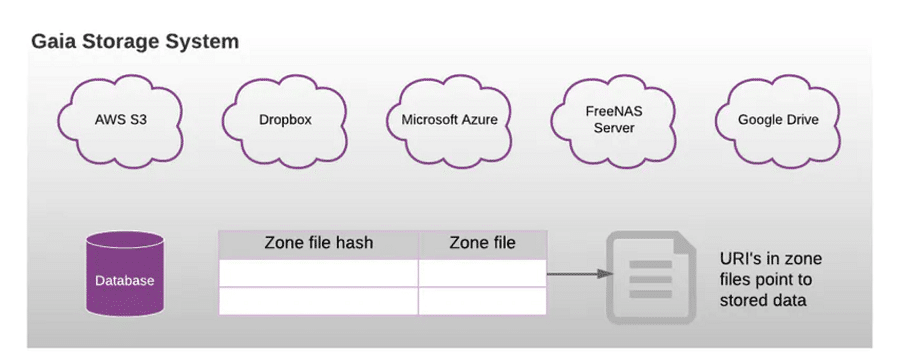
The basic architecture of Blockstack’s Gaia Storage System
It is important to note that the encryption of data generated on Blockstack is not encrypted by default. This is considered to be a “client-side” concern, meaning data management is fundamentally up to each user. That said, a user can opt to host their own personal data cloud in the Gaia Storage System if they have sufficient computing power and storage.
Clarity vs. Solidity
Clarity is the programming language used to build decentralized applications and smart contracts on Blockstack. It was built with the help of the team at Algorand, another smart contract cryptocurrency project. It will be released with the launch of Blockstack 2.0.

A technical overview of Blockstack’s architecture.
The biggest differences between Clarity and Solidity (Ethereum’s programming language) is that Clarity is not Turing complete and no code is compiled before being broadcast to the blockchain. In non-technical terms, Clarity trades off flexibility (what you can code) for more security (it is much harder to make errors). You can read more about Clarity here.
STX Cryptocurrency
STX is Blockstack’s native cryptocurrency token. It is burned to register digital assets including user identities and smart contracts to the Blockstack blockchain. However, inflation is used to pay miners on the network, meaning STX is inflationary and does not have a fixed supply. At genesis, STX had a total supply of 1.32 billion tokens.

Estimated inflation schedule for the STX token.
As you can see in the image above, although STX is inflationary, annual inflation is expected to drop from just under 5% per year to less than 1% per year in the coming decades. This is due to both the tokens burned during network participation and the reduction in newly minted STX due to the halving schedule outlined earlier.
Blockstack ICO
Blockstack has held multiple public and private sales of its STX token. Their initial 2018 and 2019 ICOs sold slightly more 1/3rd of the initial supply of 1.32 million tokens at a price of 12 cents USD per STX. If you include early investor sales, this accounts for around 50% of the initial supply.
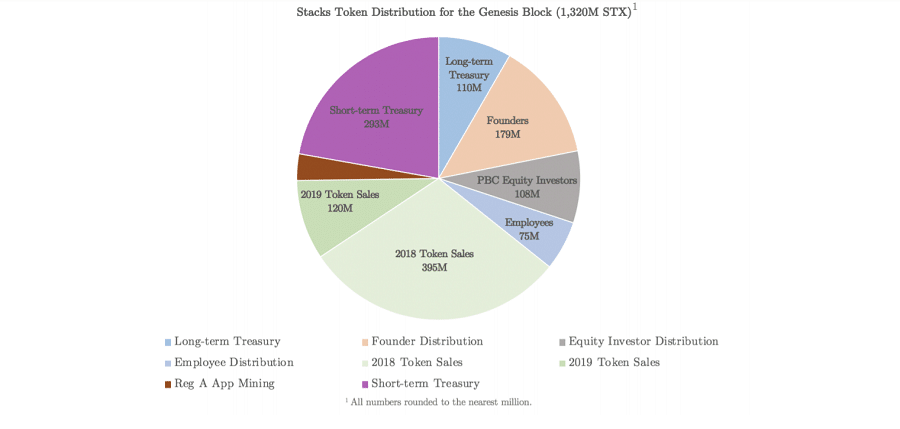
Of STX’s remaining supply initial supply, about 15% was allocated to the Blockstack team and founders, and the rest was divided between two treasuries which are managed by Blockstack. A small portion of STX tokens were also used to pay for Blockstack’s App Mining program.

Unlock schedule for the STX token. Note that this is the old emission schedule – see the last link in the text below for the updated one.
Almost all allocated tokens have their own unique vesting (release) schedules which last anywhere from 2 to 7 years. Most of these vesting schedules began in October/November 2018 when Blockstack’s genesis block was mined and the token distributions began. You can read the updated emission schedule details here.
STX Price Analysis
STX has been on the cryptocurrency market for just over a year and has not seen very impressive performance. It reached a high of almost 30 cents in August this year but has been in a slight downtrend since then. This is only a 2.5x return from the ICO price of 12 cents, and that is assuming you sold the peak (which almost nobody is able to do).

Price history of the STX token. Image via CoinMarketCap
Given that Blockstack’s 2.0 main net launch is around the corner, this could drive some demand for the STX token. This is because stacking (read: staking) the STX token offers rewards in Bitcoin, something which has yet to be seen in cryptocurrency. However, the exact economics of these rewards have yet to be detailed, and if they are not lucrative it may have next to no effect on the demand for STX.
Where To Get STX Cryptocurrency
If you are looking to bag some STX tokens, Binance is where you will need to go. Trading volume is the highest there but be cautioned that STX withdrawals are currently unavailable.

Market pairs for the STX token. Image via CoinMarketCap
It is not advised to keep your cryptocurrency on an exchange since the safety of your funds is not guaranteed. When withdrawals for STX become available on Binance, remember to move them to your own wallet.
STX Wallets
For the time being the only wallet for the STX token is Blockstack’s own desktop wallet. It is available for both Windows and macOS computers.

Disclaimer: we do not have 1.3 million STX tokens (but that would be nice).
Be sure to keep your eyes peeled as major software and hardware wallet providers are currently adding support for the STX token. You can refer to this page to keep up with these additions.
Blockstack Roadmap
In October 2020, Blockstack rebranded to Stacks. That same month, Blockstack PBC, the New York based company which develops the Blockstack ecosystem, rebranded to Hiro Systems PBC. Both rebrands were intended to signal a paradigm shift for the project. This rebrand is progress at the time of writing.
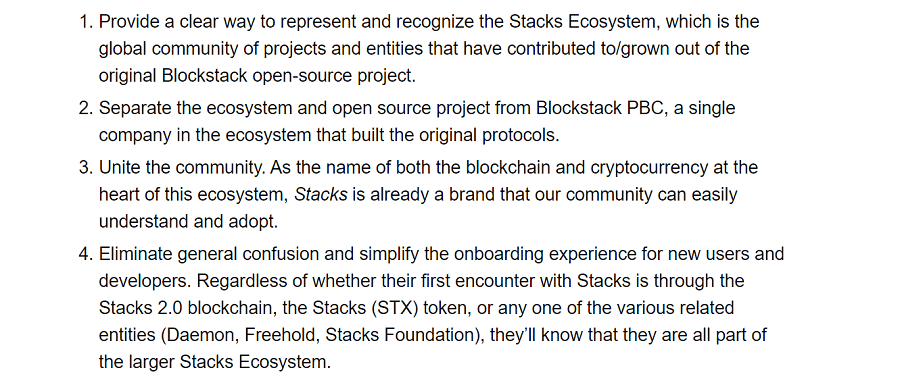
The 4 reasons why Blockstack rebranded to Stacks.
The decision to rebrand to Stacks was intended to emphasize the notion that Blockstack has gone from being a cryptocurrency project to a much bigger ecosystem. In addition, the use of a universal name for all products (e.g. Stacks blockchain, Stacks Auth, Stacks token) is hoped to make the project less confusing for newcomers.
Hiro Systems PBC is named after the protagonist of a sci fi novel called Snow Crash. This novel was very influential to Blockstack founder Muneeb Ali and was even quoted in his PhD thesis. Hiro Systems PBC intends to focus more on developing the Blockstack ecosystem and helping foster development rather than working on the blockchain itself.

Blockstack’s current roadmap gives a forecast of what to expect into 2021. Most of these goals involve growing the ecosystem using grants as well as a second iteration of their App Mining program.
While the first App Mining program was incredibly successful, the team noticed that many developers were gaming the scoring metrics to earn rewards rather than build quality apps. After consulting extensively with former participants and the Blockstack community, it is hoped that the second round will be even more successful than the first.
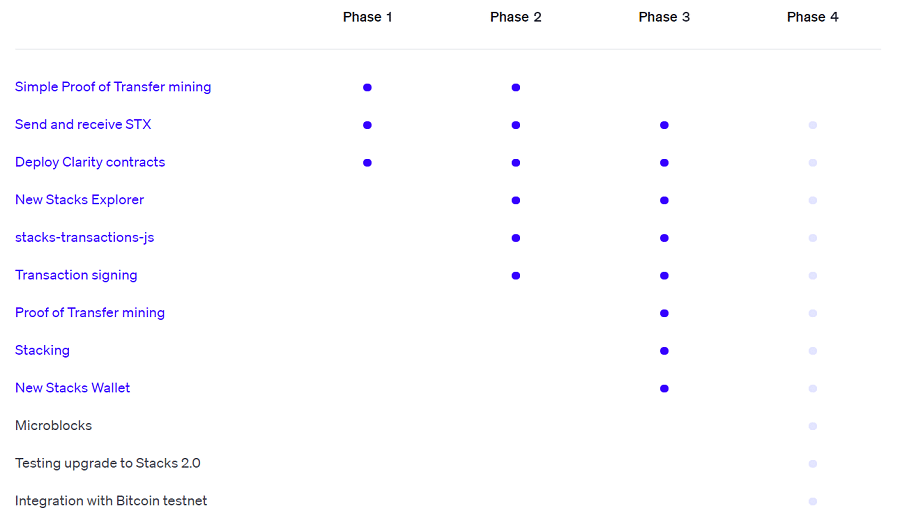
The 4 Phases of Blockstack’s 2.0 testnet.
At the time of writing, Blockstack is days away from Phase 4 of its 2.0 test-net. This is the fourth and final phase before the 2.0 main-net is launched. Blockstack’s main-net launch is expected to occur shortly after the Phase 4, assuming everything goes according to plan. The current timeline for this is December 15th.
Finally, Blockstack is intending to bring community voting to its ecosystem. The exact details of how this will work have yet to be revealed, but many interpret it as a precursor to Blockstack becoming a DAO (decentralized autonomous organization).
Why We Hold Back on Blockstack
Blockstack is by far one of the most interesting projects in cryptocurrency so far. Smart contracts and privacy on Bitcoin has long been a fantasy for many Bitcoin holders and especially for Bitcoin maximalists.
The strength of the team behind the project is a big bonus, and their commitment to cryptocurrency’s values of privacy, decentralization, and self-ownership is a cherry on top.
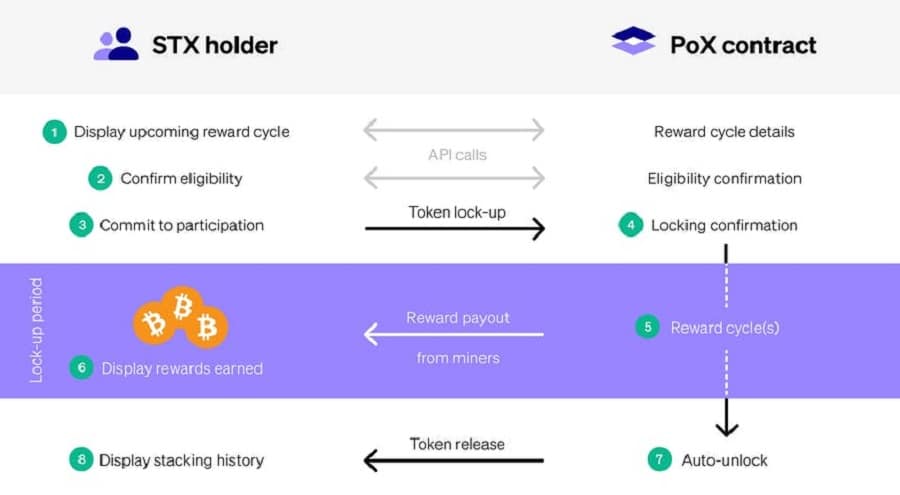
Looks good on paper, but in practice…
However, entangling Blockstack’s economic incentives with Bitcoin’s may spell disaster for the project. In a sense, the success of Blockstack depends on whether miners will commit their Bitcoin to the Blockstack blockchain. This “commitment” essentially involves trading Bitcoin for STX tokens, a trade which not many people will be willing to make during a bull market.
Moreover, a good chunk of the buy-pressure for STX tokens will come from those who are hoping to stack (aka stake) their tokens to earn the Bitcoin committed by miners. If no miners commit, no stackers will participate, and the network will never get off the ground. There are probably not many willing to let go of their Bitcoin given the current market.
Blockstack walks a fine line in this regard. On one side of the line you have the abyss of indifference – network participation has been incredibly difficult for many projects. On the other side of the line you have opportunists – the segment of the crypto community that will happily trade their Bitcoin for STX if the rewards are high enough.
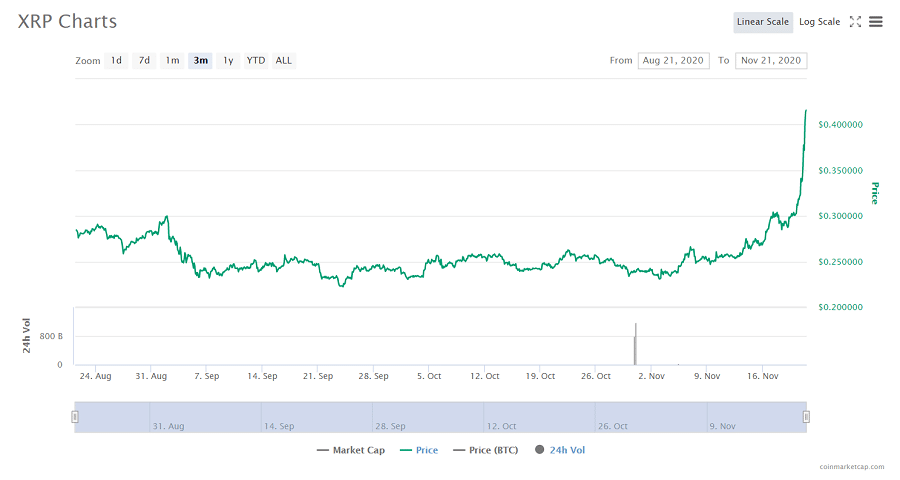
XRP’s recent price pump. It is known to have questionable fundamentals. Image via CoinMarketCap
On a positive note, XRP’s recent price pump is probably the best example of how fundamentals do not really matter all that much when it comes to the price of a cryptocurrency. Ideally though, Blockstack will survive beyond this bull market and deliver on its vision of a trustless internet. If it can properly balance incentives on its platform and draw attention to itself with clever antics, it might just hold out.
Featured Image via Shutterstock
Disclaimer: These are the writer’s opinions and should not be considered investment advice. Readers should do their own research.
- 000
- 2019
- 2020
- 2021
- 7
- access
- advice
- All
- Amazon
- Antonopoulos
- app
- Application
- applications
- apps
- architecture
- around
- article
- Assets
- AUGUST
- autonomous
- AWS
- Azure
- berlin
- BEST
- Biggest
- Billion
- binance
- Bitcoin
- Bitcoin Holders
- Bitcoin Miners
- blockchain
- BTC
- build
- Buterin
- california
- chances
- change
- Cloud
- code
- Coin
- CoinBureau
- Coindesk
- Coins
- coming
- commission
- community
- company
- computer science
- computers
- computing
- computing power
- conferences
- Consensus
- consulting
- contract
- contracts
- Credentials
- crypto
- crypto community
- cryptocurrency
- cryptocurrency market
- Current
- DAO
- DApps
- data
- data management
- Decentralization
- decentralized
- Decentralized Applications
- Demand
- Design
- developers
- Development
- digital
- Digital Assets
- disaster
- Drop
- Early
- Economic
- Economics
- ecosystem
- emission
- encryption
- Engineering
- ethereum
- Event
- exchange
- Face
- facing
- fair
- featured
- fine
- First
- Flexibility
- Focus
- founder
- founders
- function
- Fundamentals
- funding
- funds
- gaming
- Genesis
- Giving
- Goals
- good
- grants
- Growing
- Halving
- Hardware
- Hardware Wallet
- High
- hiro
- history
- hold
- hoping
- How
- HTTPS
- Humanity
- ICO
- ICOs
- Identification
- Identity
- image
- Including
- inflation
- information
- Initial Coin Offering
- Internet
- investment
- investor
- issues
- IT
- language
- launch
- launches
- Level
- Line
- LINK
- Liquid
- Long
- macos
- major
- management
- Market
- Markets
- mechanical engineering
- Metrics
- Microsoft
- million
- Miners
- Mining
- Monero
- move
- net
- network
- New York
- Notion
- offering
- Offers
- Opinions
- Other
- Paper
- paradigm
- Pay
- People
- performance
- personal data
- platform
- Platforms
- power
- price
- princeton
- privacy
- Privacy coins
- private
- Products
- Program
- Programming
- project
- projects
- proof
- protagonist
- public
- quality
- readers
- reasons
- research
- research and development
- REST
- review
- Rewards
- Safety
- sales
- scaling
- Science
- Securities
- Securities and Exchange Commission
- security
- seed
- Seed funding
- sense
- shift
- Short
- Simple
- small
- smart
- smart contract
- Smart Contracts
- So
- Software
- sold
- solidity
- speakers
- stake
- Staking
- stanford
- start
- States
- storage
- stores
- street
- success
- successful
- supply
- support
- surprise
- system
- Systems
- tech
- Technical
- time
- token
- Tokens
- top
- trade
- trades
- Trading
- turing
- United
- United States
- Universal
- university
- us
- USD
- users
- value
- View
- vision
- visualization
- vitalik
- vitalik buterin
- volume
- Voting
- W3
- Wallet
- web
- Website
- What is
- WHO
- windows
- Work
- writing
- XRP Price
- year
- years
- youtube
- Zcash


